I think it goes without saying that we need more of these 2 terms in our lives. Whether it’s studying for the MCAT or even just doing the daily tasks like getting groceries or doing the laundry, I think we all wish we had an endless supply of work and energy!
Regardless, work and energy are 2 important, interrelated concepts on the MCAT that not just appear as test questions, but are even used (believe it or not) to model the physiological function!
In this chapter overview, we’ll go over some basic definitions and concepts involving work and energy. Let’s dive in and get started!
Work and Energy on the MCAT: What You Need to Know
Topics on work and energy will be tested on the Chem/Phys section of the MCAT and can appear both as passage based and fundamental discrete questions.
We’ve calculated around 4-6 questions on average can possibly appear on the MCAT covering work and energy.
Introductory physics accounts for 25% of the content covered in the Chemical and Physical Foundations of Biological Systems.
Important Sub-Topics: Work and Energy
Work and energy are best covered and explained when put in the context of examples, which we’ll for sure display and give you in the chapter overview as we go along!
In addition, we suggest covering this chapter overview first before moving on to our “Thermodynamics on the MCAT!” and its associated articles as some of the content covered here will be helpful as a building block for the topics covered in thermodynamics.
1. Concepts of Energy
Let’s first begin by giving a basic definition of energy, which simply is a quantity which describes a system’s capacity to do work. We’ll define work later but in a more general sense, we can think of energy as a capacity to do something. For example, we need energy to push a cart up a ramp.
There are 2 main types of energy: potential and kinetic energy, both of which use the SI units joules (J) which is equal to kgᐧm2/s2. Potential energy is the energy stored within an object due to its position relative to many factors such as height, electrostatics, etc. Kinetic energy is the energy associated with a moving object!
The 2 heavily tested potential energies on the MCAT are gravitational potential energy and elastic potential energy. In gravitational potential energy, potential energy is measured based on the object’s height position relative to a ground position called a datum.
In elastic potential energy, potential energy is measured based on how displaced an object is from its elastic equilibrium state. In more simpler terms, an object attached to an elastic material, like a spring, can store elastic potential energy when it's stretched or compressed! Look below for some high yield equations!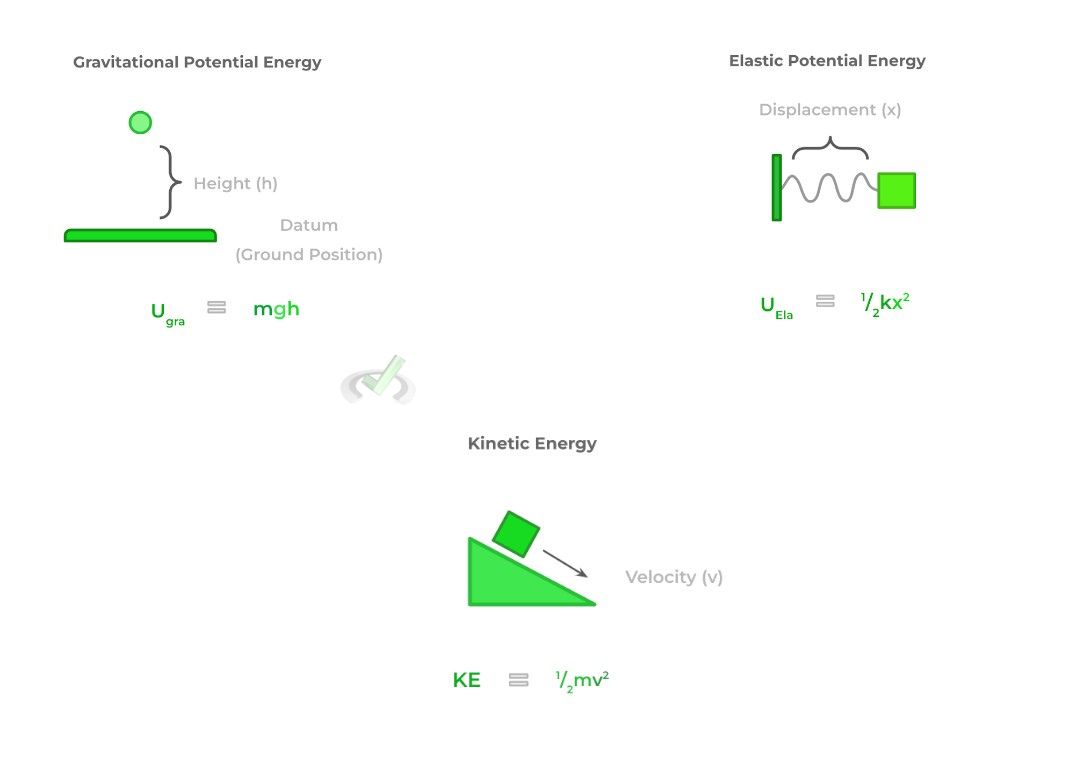
When we add up all the potential energy and kinetic energy of an object, we get a total sum of energy called total mechanical energy. This is given by the equation below!
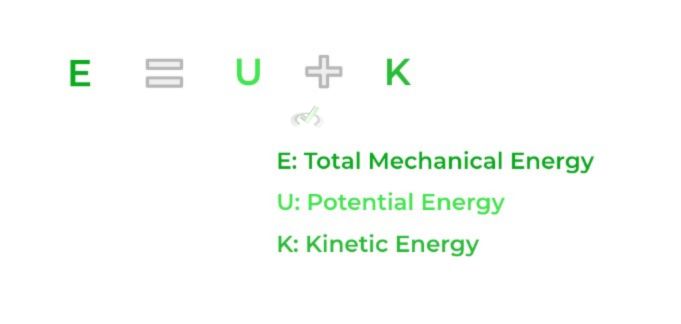
This equation is basically just a reiteration of the first law of thermodynamics which postulates the conservation of energy: energy is neither created or destroyed. Another way to think of it is that any change in an object’s potential energy is accompanied by a change in its kinetic energy.
Take this example! Suppose a ball is up a structure and is not moving. At this point, it has gravitational potential energy but no kinetic energy. As the ball is pushed down the structure, it begins to fall and gains kinetic energy. However, because the height of the ball is decreasing, its gravitational potential energy also decreases!
Note, however, that this is a rough simplification as realistically there are other ways energy can be transferred and dissipated. For example, in reality, the interaction of the falling ball with air resistance causes friction and causes some of the ball’s energy to be released as thermal energy.
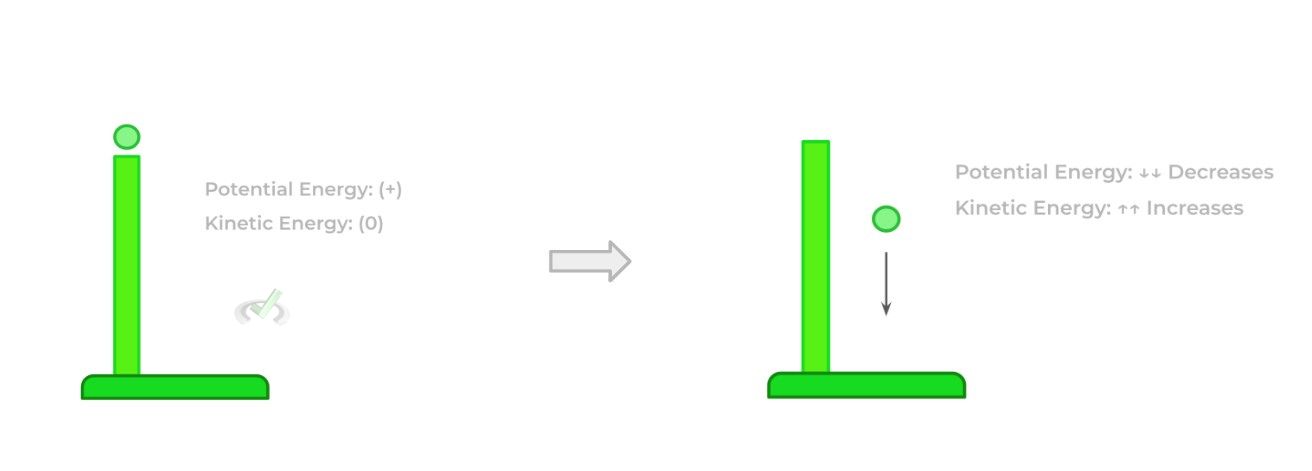
Full Study Notes : Concepts of Energy
For more in-depth content review on concepts of energy, check out these detailed lesson notes created by top MCAT scorers.
2. Concepts of Work
We’ve already described energy as the capacity to do work. Similar to heat, work describes the transfer of energy between 2 objects or systems! This is perhaps best demonstrated via an example: Suppose there’s a frictionless surface a ball is moving to the right with some velocity and thus some kinetic energy.
Suppose also in its path is a square object. When the ball strikes the square object, it does work on the square (i.e. transfer its kinetic energy) to where now the square object has some kinetic energy and begins moving!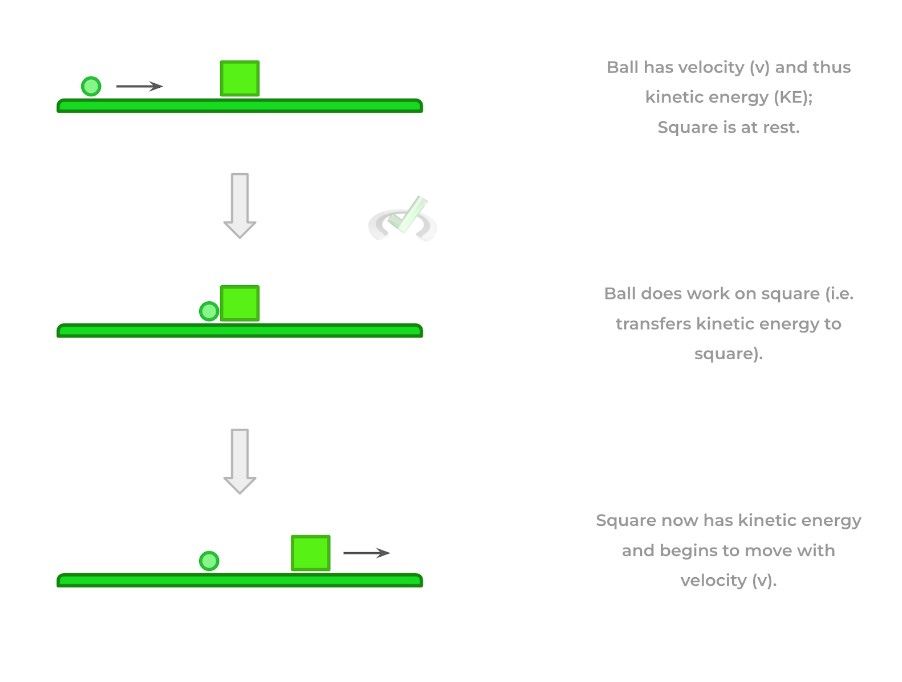
Below are some common ways to find the value of work. The equation models work product of the magnitude of force (F), distance of displacement (d), and the cos angle between the force vector and the displacement vector (𝜽).
Additionally, work can also be calculated in a pressure-volume graph by finding the area under a pressure-volume curve. Don’t worry too much about the rationale behind why this relationship occurs as we’ll explain in more depth in our article. For now, just internalize this relationship!

Full Study Notes : Concepts of Work
For more in-depth content review on concepts of work, check out these detailed lesson notes created by top MCAT scorers.
3. The Work-Energy Theorem
This theorem is so useful and helpful because it gives us a great relationship between work and energy. Specifically, the net work done by (or on) and object is equal to the change in kinetic energy of that object as indicated by the equation below:

Note depending on the sign of work (W), we can determine whether the object did work or had work done upon it!
If the value is positive (+), the work was done on the object as it gained kinetic energy. If the value is negative (-), the object did work as it decreased in kinetic energy!
Consider the light green ball as the object of interest. The 2 visual scenarios can help illustrate the difference between whether a value is positive or negative.
Full Study Notes : The Work-Energy Theorem
For more in-depth content review on the work-energy theorem, check out these detailed lesson notes created by top MCAT scorers.
4. Mechanical Advantage
Have you ever used a ramp when pushing a luggage cart or tried to pull a piñata up with a rope over a tree branch and realize how these things made those tasks a lot easier? We can thank the mechanical advantage that these physics tools provide which makes these tasks a lot easier.
Physics tools that provide mechanical advantage act as a force multiplier where you apply an initial, input force which results in a greater, output force. The equation for mechanical advantage is given below:
However, an important concept that must be addressed when talking about mechanical advantage is that there is NO generation of energy as this violates the conservation of energy postulate: all work remains constant.
What’s different is that the force is applied over a larger distance -- this allows us to have a decreased force while still having the same amount of work done. Consider the example of one of the most basic physics tools: the lever.
As shown, we’re trying to lift up the square by a small distance (d2) which requires a force (F2). If we use a lever and set the fulcrum near to the square, we can apply a much smaller force (F1) but this time pushing down over a larger distance (d1). Think of it like an inverse proportion!
Now everything should balance out: we apply a small, initial force at one end over a large distance which is amplified to produce a larger, output force to move the square a small distance.
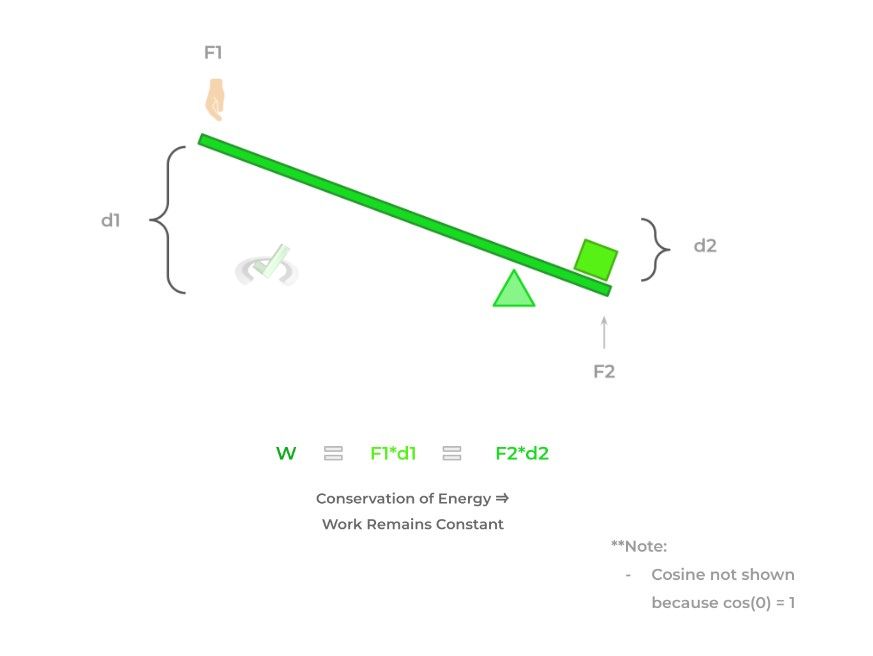
Full Study Notes : Mechanical Advantage
For more in-depth content review on mechanical advantage, check out these detailed lesson notes created by top MCAT scorers.
Important Definitions and Key Terms
Below are some high yield definitions and key terms to refer to when reviewing concepts and ideas about work and energy!
Term | Definition |
|---|---|
Energy | A quantity which describes an object’s or system’s ability to do work |
Potential Energy | The stored energy of an object due to the object’s position relative to a “ground” or equilibrium position |
Kinetic Energy | The energy of an object associated with an object’s movement |
Total Mechanical Energy | The sum of an object’s potential and kinetic energy |
Work | Describes the process of energy transfer |
Work-Energy Theorem | Theorem which states that the total net work done (or by) an object is equal to the change of its kinetic energy |
Mechanical Advantage | The ability of physics tools to create a greater output force by only applying a small input force |
Additional Reading Links – Study Notes for Work and Energy on the MCAT
Additional Reading: Physics Topics on the MCAT:
- Circuits on the MCAT
- Electrostatics on the MCAT
- Fluids on the MCAT
- Kinematics on the MCAT
- Light and Optics on the MCAT
- Magnetism on the MCAT
- Thermodynamics on the MCAT
- Units and Dimensional Analysis on the MCAT
- Waves and Sound on the MCAT
- Atomic and Nuclear Phenomena on the MCAT







 To help you achieve your goal MCAT score, we take turns hosting these
To help you achieve your goal MCAT score, we take turns hosting these 





















 reviews on TrustPilot
reviews on TrustPilot